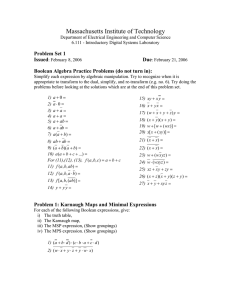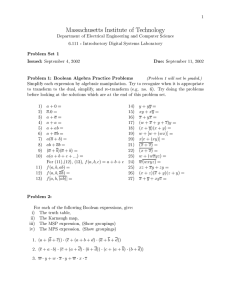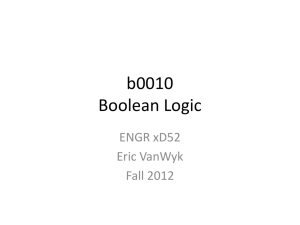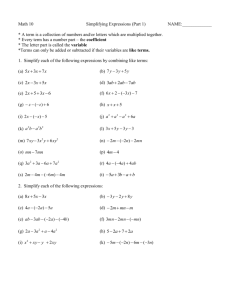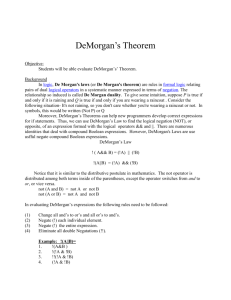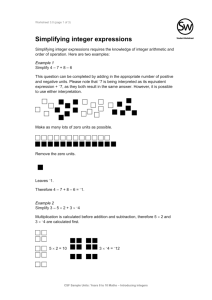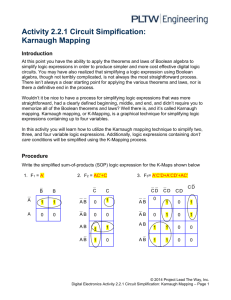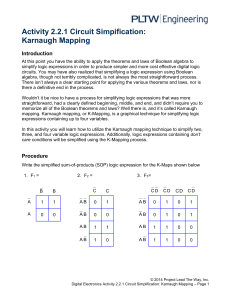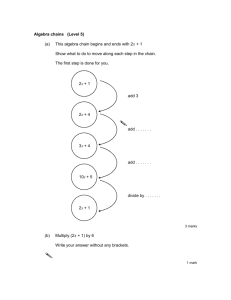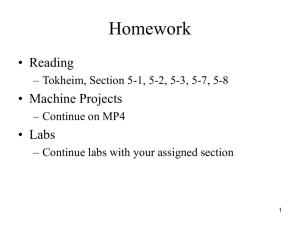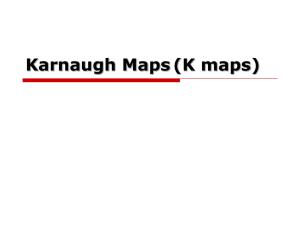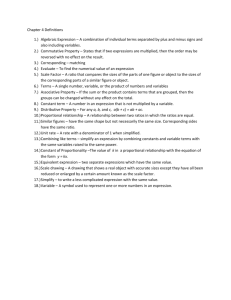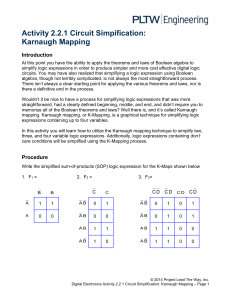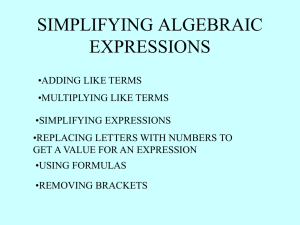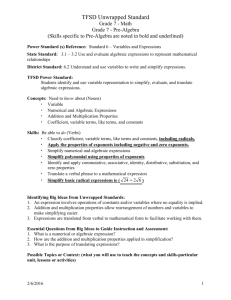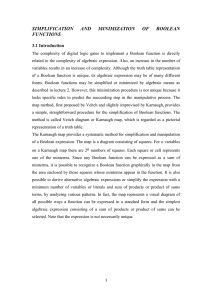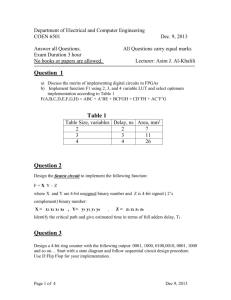Massachusetts Institute of Technology
advertisement
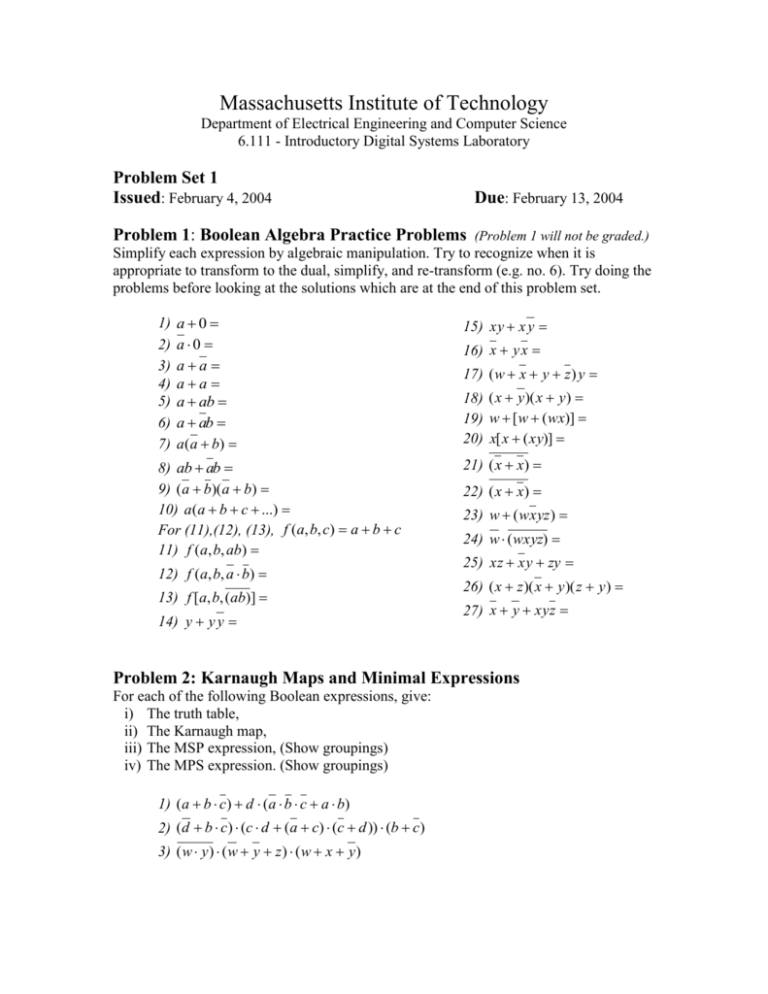
Massachusetts Institute of Technology Department of Electrical Engineering and Computer Science 6.111 - Introductory Digital Systems Laboratory Problem Set 1 Issued: February 4, 2004 Due: February 13, 2004 Problem 1: Boolean Algebra Practice Problems (Problem 1 will not be graded.) Simplify each expression by algebraic manipulation. Try to recognize when it is appropriate to transform to the dual, simplify, and re-transform (e.g. no. 6). Try doing the problems before looking at the solutions which are at the end of this problem set. 1) 2) 3) 4) 5) 6) 7) a0 a0 aa aa a ab a ab a ( a b) 8) ab ab 9) (a b)( a b) 10) a(a b c ...) For (11),(12), (13), f (a, b, c) a b c 11) f (a, b, ab) 12) f (a, b, a b) 13) f [a, b, (ab)] 14) y y y 15) xy x y 16) x y x 17) ( w x y z ) y 18) ( x y )( x y ) 19) w [ w ( wx)] 20) x[ x ( xy)] 21) ( x x) 22) ( x x) 23) w ( w x yz ) 24) w (wxyz) 25) xz x y zy 26) ( x z )( x y )( z y ) 27) x y xy z Problem 2: Karnaugh Maps and Minimal Expressions For each of the following Boolean expressions, give: i) The truth table, ii) The Karnaugh map, iii) The MSP expression, (Show groupings) iv) The MPS expression. (Show groupings) 1) (a b c) d (a b c a b) 2) (d b c) (c d (a c) (c d )) (b c) 3) ( w y ) ( w y z ) ( w x y ) 6.111 Spring 2004 Problem Set 1 2 Problem 3: Karnaugh Maps with “Don’t Cares” Karnaugh Maps are useful for finding minimal implementations of Boolean expressions with only a few variables. However, they can be a little tricky when “don't cares” (X) are involved. Using the following K-Maps: ab ab 00 01 11 10 00 X 1 1 X 01 1 1 0 11 1 0 10 X 0 cd 00 01 11 10 00 1 1 1 0 0 01 0 X 0 0 0 1 11 1 0 X 1 0 1 10 1 0 0 0 cd (2) (1) i) ii) iii) iv) Find the minimal sum of products expression. Show your groupings. Find the minimal product of sums expression. Show your groupings. Are your solutions unique? If not, list and show the other minimal expressions. Does the MPS = MSP? Problem 4: DeMorgan’s Theorem Use DeMorgan's Theorems to simplify the following expressions: 1) (a d ) (a c) 2) a b c 3) a d a c c d Problem 5: Setup and Hold Times for D Flip-Flop (Flip-flops will be covered in lecture on Wednesday Feb. 11) 1) Let a D latch be implemented using a mux and realized as follows: G D 0 1 Q º G Q D G I1 I2 6.111 Spring 2004 Problem Set 1 3 You may assume the following: a) G and G are complements and have zero delay, i.e. when G is 1, G is exactly 0, and vice versa. b) Assume the switches are ideal, with no delay. E.g. when G is 0, the switch is open. c) The propagation delay of the inverters is tinv. Also, the contamination delay is equal to the propagation delay. What is the setup and hold time of this latch? 2) What memory element is created when two muxes are cascaded as in the figure below? Assume that CLK and CLK are complements with zero delay. D ? CLK Q º D 0 1 CLK 0 1 Q CLK 3) What are the setup time, hold time, and clock to output delay of the above memory element? 6.111 Spring 2004 Problem Set 1 Solutions to Problem 1: Boolean Algebra Practice Problems 1) 2) 3) 4) 5) a0 a a0 0 a a 1 aa a a ab a (1 b) a 6) a ab (a a)( a b) a b 7) a (a b) a a ab ab 8) ab ab b(a a) b 9) (a b)( a b) a a ab ba bb a ab ab a(1 b b) a 10) a(a b c ...) aa ab ac ... a ab ac ... a 11) f (a, b, ab) a b ab a b 12) f (a, b, a b) a b ab a b a 1 13) f [a, b, (ab)] a b (ab) a b a b 1 14) y y y y 15) xy x y x( y y ) x 16) x y x x(1 y ) x 17) ( w x y z ) y y 18) ( x y )( x y ) x 19) w [ w ( wx)] w 20) x[ x ( xy)] x 21) ( x x) x 22) ( x x) 0 23) w ( w x yz ) w(1 x yz ) w 24) w ( wxyz) w( w x y z ) w 25) xz x y zy xz x y 26) ( x z )( x y )( z y ) ( x z )( x y ) 27) x y xy z x y z 4
